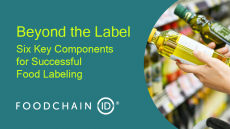FDA issues new guidance on lead in candy
the maximum levels of lead allowed in children's candy.
The new recommendations, published this month by the Food and Drug Administration (FDA), sets maximum lead allowance at one fifth of previous levels.
The agency said that although the new recommendations of 0.1 parts per million (ppm) are not legally required, it is prepared to take enforcement action against any candy product containing lead levels that may pose a health risk.
This overrides previous guidance provided by the FDA in its 1995 letter to industry, which stated that regulatory action would be considered against candy with lead levels that exceed 0.5ppm.
"FDA intends to consider several factors in bringing enforcement actions regarding lead in candy, including the level of lead present, the best available consumption data, and the lead exposure that would result from consumption of the product," said the agency in its new guidance documents.
The agency said its new suggested maximum levels are achievable under good manufacturing practices in the production of candy and candy ingredients.
Candy products were not known to be a significant food source of lead until 1994, when California authorities found that an imported candy product from Mexico was contaminated with lead that had migrated into the candy from lead-based ink used in the candy's packaging.
After the problem was detected the FDA began testing other candy products with lead-based printing inks on their packaging. The tests found that in addition to the printing ink problem, some imported candy products from Mexico contained higher lead levels than were typically found in domestic candy products.
The FDA determined that the higher lead levels were largely associated with chili.
The regulator subsequently advised manufacturers, importers, and distributors that it would consider taking regulatory action against candy meant for small children with lead levels that exceeded 0.5ppm.
The 0.5 ppm guideline was, at that time, equivalent to the Food Chemicals Codex (FCC) specification for lead in sugar, the main ingredient in many candy products.
Sugar is made by a re-crystallization process, which when carried out under good manufacturing practices, typically results in low parts per billion or undetectable lead levels in the final product.
The FDA typically finds low parts per billion or undetectable levels of lead in sugar-based candies it analyzes in its monitoring activities. While the manufacture of chocolate does not involve a re-crystallization process, most finished milk chocolate products contain lead levels well below 0.1 ppm.
The regulatory body said its new levels are designed to reduce consumers' lead exposure to the lowest level that can be practicably obtained.
For more information on the new guidance documents, click here.

















